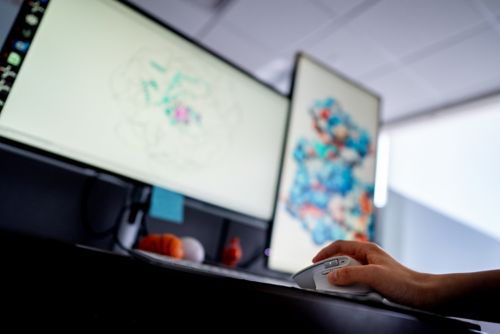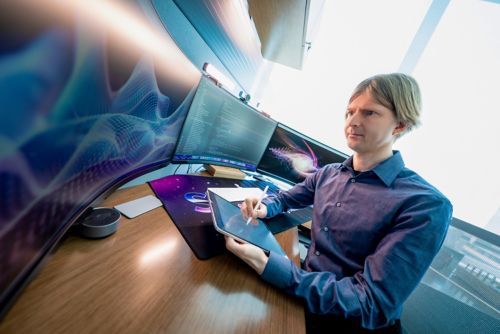St. Jude Family of Websites
Explore our cutting edge research, world-class patient care, career opportunities and more.
St. Jude Children's Research Hospital Home

- Fundraising
St. Jude Family of Websites
Explore our cutting edge research, world-class patient care, career opportunities and more.
St. Jude Children's Research Hospital Home

- Fundraising
Christoph Gorgulla Lab
Developing next generation methods for computational biology and ligand/drug discovery.
Overview
Drug discovery is a multistep research process which identifies, optimizes and validates small molecules and biologics that can be further refined and tested in pre-clinical and clinical settings. This process is costly and labor-intensive; it often takes a decade or more to make metabolically stable, permeable compounds with minimal off-target effects available to patients. Our research group is interested in developing and integrating next generation computational methods into the process of drug discovery. Our goal is to generate higher quality potential drug candidates for testing and reduce the resources required to discover these molecules.
Gorgulla research summary
There are an estimated 1060 possible compounds to sort through when searching for small molecules that bind a specific target, highlighting the need for streamlined approaches dedicated to making drug discovery as efficient as possible. For the past few decades, virtual screenings – computational techniques to identify promising drug candidates – have been used to increase efficiency and cut down on the resource-intensive process of drug discovery. Our group develops next generation methods – such as machine learning, ultra- large virtual screens and quantum computing – that can surpass the abilities of traditional virtual screens by simultaneously exploring a larger chemical space and homing in on specific molecular properties of interest.
Method development
Experimental high throughput screening methods rely on automation and robotics to test tens to hundreds of thousands of compounds but by leveraging the power of computational technologies, ultra-large virtual screenings can sample libraries of billions of small molecules and often overcome some of the traditional limitations of experimental high-throughput screens. Generative machine learning models can furthermore explore the entire chemical space of druglike molecules.
Our laboratory develops and optimizes drug development methods based on quantum chemistry, quantum computing, artificial intelligence and high-performance computing. Specifically, we are interested in (1) qualitatively and quantitatively approaching drug discovery through a combinatorial approach involving ultra-large virtual screenings, generative machine learning models and free energy simulations, (2) utilizing quantum mechanics to predict molecular properties of interest with high accuracy and (3) developing novel algorithms, methods and software for quantum computing to further improve our ability to predict molecular properties of interest.

Applied drug discovery
The true test of a new computational method lies in its performance in real-world application. We actively engage in ligand discovery projects to validate our approaches against challenging biological targets. This provides critical feedback for refining our methods and allows us to make a direct impact by discovering novel biologically active molecules. These compounds serve as valuable tool compounds for research or as starting points for new drug candidates, thereby accelerating both biological understanding and therapeutic development.
In a landmark study targeting the NRF2/KEAP1 protein-protein interaction (PPI), we performed the first ever ultra-large virtual screen against a PPI, leading to the discovery of potent inhibitors. Furthermore, our computational workflow has identified and validated novel inhibitors for NADPH oxidases (NOXs), enzymes implicated in cancer and other pathologies. We have also applied our discovery platforms to other high-impact targets, including those relevant to the COVID-19 pandemic. These projects showcase the broad applicability of our computational VirtualFlow platform.

In a pioneering study involving quantum computing, we demonstrated the power of our hybrid quantum-classical approach by performing the first ever discovery of experimentally validated ligands using a quantum computer. As proof-of-concept, we targeted the KRAS protein, a notoriously difficult-to-drug cancer driver. Our generative hybrid quantum-classical machine learning model identified novel molecules that were then synthesized and biochemically validated, proving the unique power of this method for tackling proteins previously considered "undruggable."
As we move forward, our group is particularly interested in epigenetic targets that play a role in cancer.
Publications
About Christoph Gorgulla

Dr. Gorgulla has an interdisciplinary scientific educational background including bachelor’s degrees in molecular biology with bioinformatics and mathematics, a master’s degree in mathematics (focusing on quantum physics) from Freie Universität Berlin, and a PhD focusing on computational drug discovery through a joint program from the Max Planck Institute for Molecular Genetics, the Department of Mathematics and Computer Science at Freie Universität Berlin and the Berlin Mathematical School. He also completed a postdoctoral fellowship at Harvard University and Dana-Farber Cancer Institute in Boston, Massachusetts.
Dr. Gorgulla was a Lead Scientist in the Department of Structural Biology, leading the Ligand Discovery Team of the Structural Biology Blue Sky Initiative before becoming an Assistant Member of the St. Jude Faculty in the Department of Structural Biology. His research interests are focused on utilizing artificial intelligence, quantum physics/chemistry, high-performance computing and quantum computing to identify more effective novel therapeutics and to reduce the resources in the process of drug development.
Affiliations
Contact us
Christoph Gorgulla, PhD
Assistant Member, St. Jude Faculty
Department of Structural Biology
MS 311, M7428
St. Jude Children’s Research Hospital

Memphis, TN, 38105-3678 USA GET DIRECTIONS